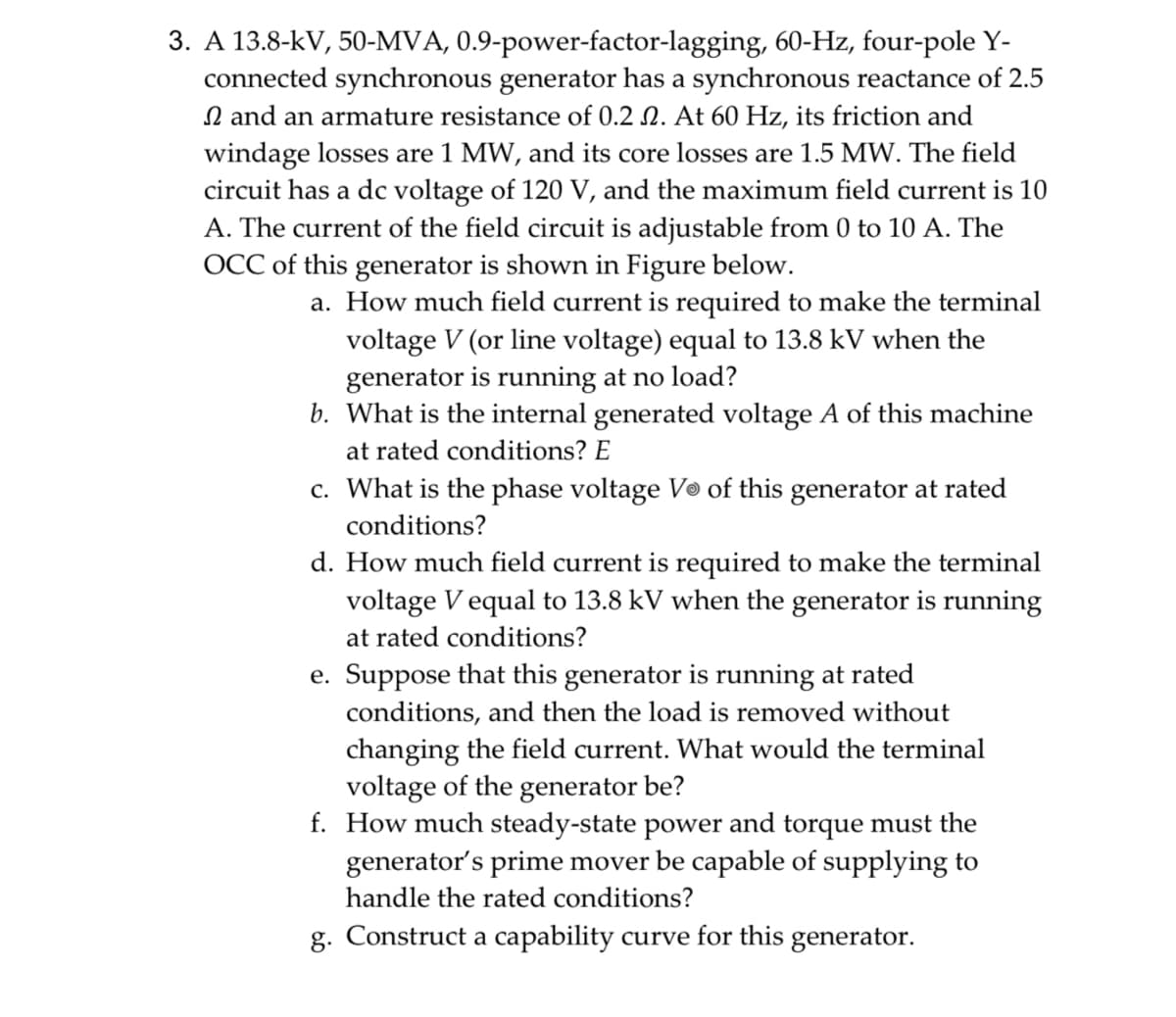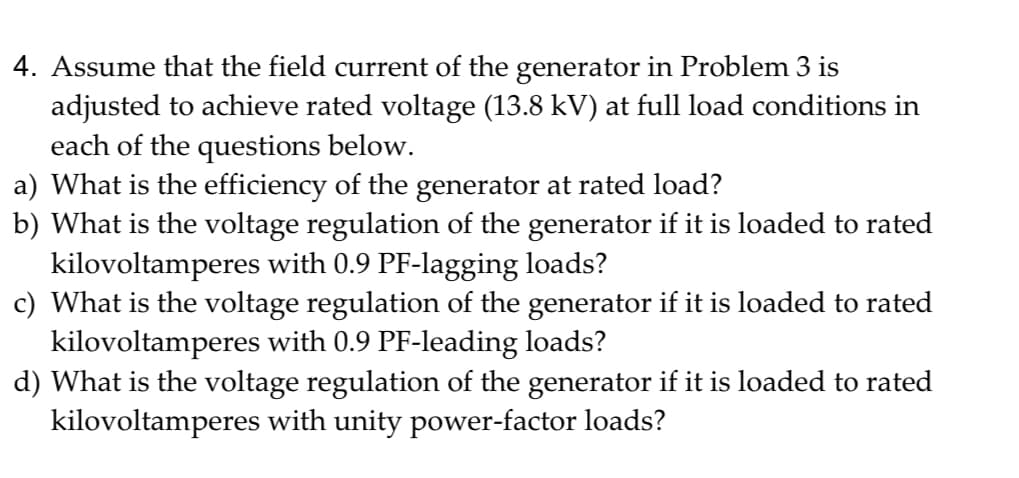3. A 13.8-kV, 50-MVA, 0.9-power-factor-lagging, 60-Hz, four-pole Y- connected synchronous generator has a synchronous reactance of 2.5 2 and an armature resistance of 0.2 2. At 60 Hz, its friction and windage losses are 1 MW, and its core losses are 1.5 MW. The field circuit has a dc voltage of 120 V, and the maximum field current is 10 A. The current of the field circuit is adjustable from 0 to 10 A. The OCC of this generator is shown in Figure below. a. How much field current is required to make the terminal voltage V (or line voltage) equal to 13.8 kV when the generator is running at no load? b. What is the internal generated voltage A of this machine at rated conditions? E c. What is the phase voltage Vo of this generator at rated conditions? d. How much field current is required to make the terminal voltage V equal to 13.8 kV when the generator is running at rated conditions? e. Suppose that this generator is running at rated conditions, and then the load is removed without changing the field current. What would the terminal voltage of the generator be? f. How much steady-state power and torque must the generator's prime mover be capable of supplying to handle the rated conditions? g. Construct a capability curve for this generator.
3. A 13.8-kV, 50-MVA, 0.9-power-factor-lagging, 60-Hz, four-pole Y- connected synchronous generator has a synchronous reactance of 2.5 2 and an armature resistance of 0.2 2. At 60 Hz, its friction and windage losses are 1 MW, and its core losses are 1.5 MW. The field circuit has a dc voltage of 120 V, and the maximum field current is 10 A. The current of the field circuit is adjustable from 0 to 10 A. The OCC of this generator is shown in Figure below. a. How much field current is required to make the terminal voltage V (or line voltage) equal to 13.8 kV when the generator is running at no load? b. What is the internal generated voltage A of this machine at rated conditions? E c. What is the phase voltage Vo of this generator at rated conditions? d. How much field current is required to make the terminal voltage V equal to 13.8 kV when the generator is running at rated conditions? e. Suppose that this generator is running at rated conditions, and then the load is removed without changing the field current. What would the terminal voltage of the generator be? f. How much steady-state power and torque must the generator's prime mover be capable of supplying to handle the rated conditions? g. Construct a capability curve for this generator.
Power System Analysis and Design (MindTap Course List)
6th Edition
ISBN:9781305632134
Author:J. Duncan Glover, Thomas Overbye, Mulukutla S. Sarma
Publisher:J. Duncan Glover, Thomas Overbye, Mulukutla S. Sarma
Chapter11: Transient Stability
Section: Chapter Questions
Problem 11.8P
Related questions
Question
Please answer problem 4. I attached problem 3 because problem 4 required problem 3

Transcribed Image Text:3. A 13.8-kV, 50-MVA, 0.9-power-factor-lagging, 60-Hz, four-pole Y-
connected synchronous generator has a synchronous reactance of 2.5
and an armature resistance of 0.2 2. At 60 Hz, its friction and
windage losses are 1 MW, and its core losses are 1.5 MW. The field
circuit has a dc voltage of 120 V, and the maximum field current is 10
A. The current of the field circuit is adjustable from 0 to 10 A. The
OCC of this generator is shown in Figure below.
a. How much field current is required to make the terminal
voltage V (or line voltage) equal to 13.8 kV when the
generator is running at no load?
b. What is the internal generated voltage A of this machine
at rated conditions? E
c. What is the phase voltage Vo of this generator at rated
conditions?
d. How much field current is required to make the terminal
voltage V equal to 13.8 kV when the generator is running
at rated conditions?
e. Suppose that this generator is running at rated
conditions, and then the load is removed without
changing the field current. What would the terminal
voltage of the generator be?
f. How much steady-state power and torque must the
generator's prime mover be capable of supplying to
handle the rated conditions?
g. Construct a capability curve for this generator.

Transcribed Image Text:4. Assume that the field current of the generator in Problem 3 is
adjusted to achieve rated voltage (13.8 kV) at full load conditions in
each of the questions below.
a) What is the efficiency of the generator at rated load?
b) What is the voltage regulation of the generator if it is loaded to rated
kilovoltamperes with 0.9 PF-lagging loads?
c) What is the voltage regulation of the generator if it is loaded to rated
kilovoltamperes with 0.9 PF-leading loads?
d) What is the voltage regulation of the generator if it is loaded to rated
kilovoltamperes with unity power-factor loads?
Expert Solution
This question has been solved!
Explore an expertly crafted, step-by-step solution for a thorough understanding of key concepts.
This is a popular solution!
Trending now
This is a popular solution!
Step by step
Solved in 4 steps with 3 images

Knowledge Booster
Learn more about
Need a deep-dive on the concept behind this application? Look no further. Learn more about this topic, electrical-engineering and related others by exploring similar questions and additional content below.Recommended textbooks for you

Power System Analysis and Design (MindTap Course …
Electrical Engineering
ISBN:
9781305632134
Author:
J. Duncan Glover, Thomas Overbye, Mulukutla S. Sarma
Publisher:
Cengage Learning

Power System Analysis and Design (MindTap Course …
Electrical Engineering
ISBN:
9781305632134
Author:
J. Duncan Glover, Thomas Overbye, Mulukutla S. Sarma
Publisher:
Cengage Learning